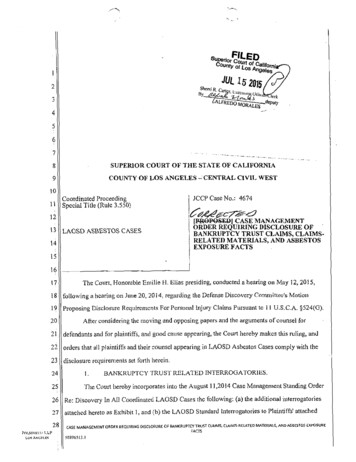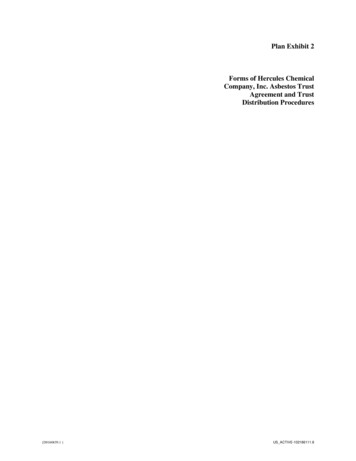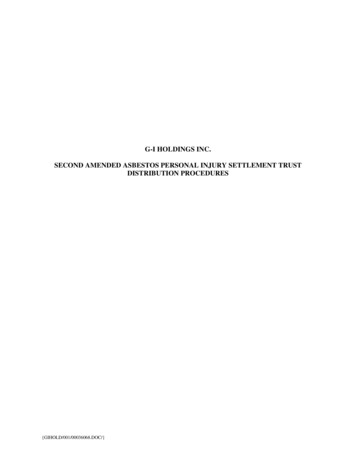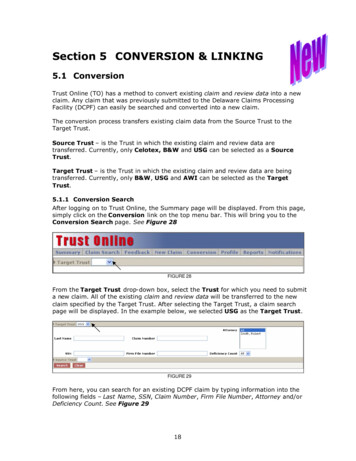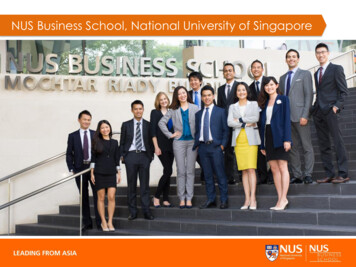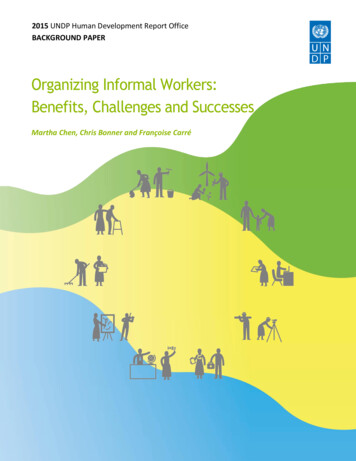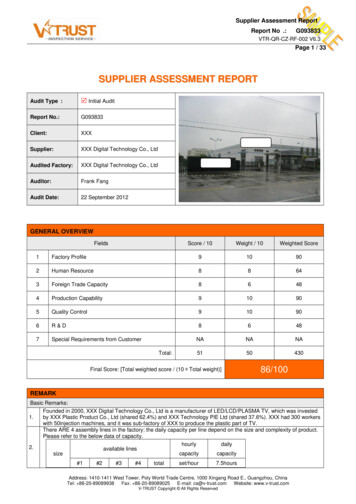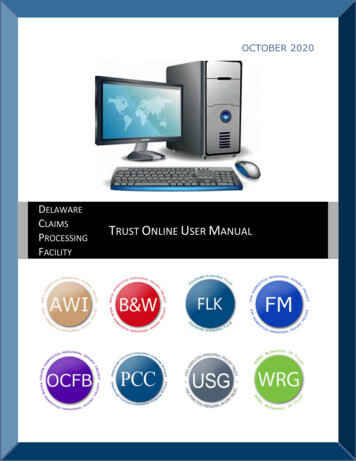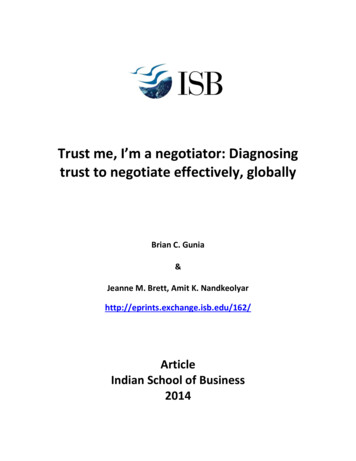
Transcription
Trust me, I’m a negotiator: Diagnosingtrust to negotiate effectively, globallyBrian C. Gunia&Jeanne M. Brett, Amit K. icleIndian School of Business2014
Trust in Negotiation 2Running Head: Trust in NegotiationTrust me, I’m a negotiator: Diagnosing trust to negotiate effectively, globallyBrian C. GuniaJohns Hopkins UniversityCarey Business School100 International Drive, 13th FloorBaltimore, MD 21202USA 1 (410) 234-9423brian.gunia@jhu.eduJeanne M. BrettNorthwestern UniversityKellogg School of Management2001 Sheridan RoadEvanston, IL 60208USA 1 (847) 491-8075jmbrett@kellogg.northwestern.eduAmit K. NandkeolyarIndian School of BusinessGachibowli,Hyderabad - 500 032INDIA 91 40 2318 7160amit n@isb.edu
Trust in Negotiation 3Appears in Organizational Dynamics, 43, 27-36.Trust me, I’m a negotiator: Diagnosing trust to negotiate effectively, globallyExecutive SummaryAround the world, negotiators who fail to trust fail to achieve their goals. In other words, trustappears to be a near-necessity that global negotiators cannot afford to ignore. Yet, fears ofexploitation make trust in negotiations scarce, so negotiators also need practical guidance on whyto trust, how to trust, and how to work within the level of trust that prevails in their ownnegotiations. Drawing from 15 years of cross-cultural negotiation research, the current paper firsthighlights the centrality of trust to negotiation, noting its influence on behaviors and ultimately onoutcomes. It then describes the scarcity of trust in negotiations around the world, and especially incertain cultures. The joint importance and scarcity of trust noted, we then provide researchvalidated guidance for diagnosing the level of trust in negotiation and putting that diagnosis intopractice through strategic adjustments. Overall, this approach helps to sensitize global negotiatorsto the importance and implications of trust.
Trust in Negotiation 4Trust me, I’m a negotiator: Diagnosing trust to negotiate effectively, globallyNegotiating effectively is no easy task, especially around the world. Yet, accumulatingresearch from numerous cultures points toward a relatively straightforward conclusion: Trust—the willingness to make yourself vulnerable by revealing information that a negotiation counterpartcould use against you—is the most direct route to high-quality agreements that satisfy both parties.At the same time, negotiators from around the world are reluctant to trust each other, fearingexploitation. Though understandable, their reluctance contributes to negotiation outcomes thateither fail to maximize value, or fail altogether. Consider a recent negotiation in India, which weanalyze in details later in the manuscript:On October 3rd, 2008, Tata Motors—owner of marquee automotive brands like Jaguar andLand Rover and a member of the 80 billion Tata group—announced that it was abandoningnegotiations with the Indian state of West Bengal: the culmination of a two-year attempt to producethe world’s cheapest car there (the 2,500 Nano). The announcement sent shock waves acrossbusiness communities in India and abroad. If Tata, one of India’s most reputed businesses, couldnot negotiate to open a production facility in West Bengal, who could? With the cold feet of manypotential investors, West Bengal’s industrialization ground to a halt, and the ruling Left Frontgovernment lost the state elections after 34 years of continuous rule.The collapse had its roots in politics: West Bengal had fallen behind other Indian states incatching the wave of industrial development. In response, the Left Front government announcedan “all-out” effort to woo Tata’s Nano plant, bringing much-needed jobs and prosperity. Evenbefore negotiations began, however, the government stoked a full-blown conflict: they used acontroversial land acquisition bill to seize 997 acres of farmland, towards Tata’s 1000-acrerequirement. Reports of forced evacuations, inadequate compensation, and delayed housingalternatives for displaced farmers proliferated, prompting massive resistance from farmers,politically fanned by a major opposition party. Ideological cracks also developed within the LeftFront government: rank-and-file members complained that party leaders had violated corecommunist convictions by aggressively recruiting Tata, an epitome of capitalism.Thus, negotiations between Tata and West Bengal’s ruling party commenced during a toxicstand-off between the ruling party and its opposition. This helps to explain why the negotiationssuffered from a substantial trust deficit from the outset, which ultimately convinced Tata to
Trust in Negotiation 5abandon West Bengal in favor of another Indian state: Gujarat. As discussed below, the behaviorof the Tata and West Bengal negotiators revealed deep-seated distrust that ultimately led to animpasse. In sharp contrast, the behavior of the Tata and Gujarat negotiators revealed the presenceof trust, which produced a mutually-beneficial deal with an INR 2,000 crore (approximately 427million) investment by Tata. This story and both of its parts illustrate the importance of trust, asdescribed below.Fifteen years of negotiation research, most recently in developing countries, has led us toconclude that trust is an infrequent but critically important feature of negotiations. In all cornersof the world, when negotiators do not trust, the tactics that they use generate poor-qualityagreements at best, and lead to impasses at worst, as with Tata. What to do? We advise negotiatorsto: 1) understand why negotiators trust; 2) diagnose the level of trust in their own negotiation; and3) adjust their strategies accordingly. In an age of cultural diversity, our goal is to call negotiators’attention to the near-universal importance of trust, which can substantially improve theirperformance at the bargaining table.Why Trust in Negotiation?Trust is critical in negotiation because, to reach agreements that satisfy both parties,negotiators typically need to engage in value creation behaviors that are too risky in the absenceof trust. Negotiation scholars have long noted that negotiations consist of both value claiming andvalue creation. Value claiming, or “slicing the pie,” includes behaviors that influence thedistribution of resources (e.g., making the first offer). Value creation, or “growing the pie,”includes behaviors that increase the resources available to claim. Without value creation,negotiators often cannot find enough value to claim, and without trust, negotiators often find ithard to create value.In particular, they often fail to share the relevant information: Value creation often requiresnegotiators to trade-off their interests (i.e., their reasons for taking the positions that they take)based on their priorities (i.e., which interests are more or less important to them). To do that, eachnegotiator must accept less-than-optimal terms on their low-priority interests in return for optimalterms on their high-priority interests. To do that, negotiators need to understand not only their owninterests and priorities, but also something about their counterpart’s interests and priorities, i.e.,they need to reach “insight.” Many years of negotiation research show that the most efficient way
Trust in Negotiation 6to reach insight is through an exchange of honest information, and honestly sharing information,of course, requires the negotiators to achieve some level of trust.In essence, trusting allows negotiators to share a little confidential information about theirinterests and priorities even though their counterpart could use that information to exploit them.Trusting negotiators assume that exploitation will not occur, but rather that their counterpart willshare some information in return. Trust, then, amounts to a bet that the counterpart will reciprocaterather than exploit. As it turns out, trusting represents a fairly good bet. The universal norm ofreciprocity means that people reciprocate the behaviors directed toward them, in social interactionsfrom greeting behavior to negotiation. For example, negotiators engage in reciprocal trust,cooperation, information-sharing, and even non-verbal behavior (by mimicking each other’sgestures). Of course, reciprocity is a two-way street: In addition to trust and cooperation,negotiators also reciprocate distrust and competition. In short, reciprocity synchronizes two peoplearound an early pattern of behaviors, so trusting enough to kick-start a reciprocal informationsharing cycle is both critical and advisable. Wise negotiators understand what trust is, what it doesfor information-sharing, how it operates through reciprocity to produce tradeoffs, and how itsabsence can produce unhelpful reciprocity that can derail a negotiation.That negotiators should trust does not necessarily mean that they do. In general, peopledecide whether to trust for a multitude of reasons. They may have a tendency to trust based ontheir culture, personality, or past experiences. Or they may condition their trust on characteristicsof their immediate environment, from its physical features like the presence of airborne oxytocinto its social features like the behavior of others. Among the many factors that could influence trustin negotiations, our research has focused on culture, showing that negotiators’ culture can stronglyinfluence how much they trust one another. Informally defined as the unique character of a groupand formally defined as the complex, loosely-integrated system of psychological, sociological,economic, and political processes that groups develop to address their problems of socialinteraction; culture can influence a wide range of behaviors at and away from the bargaining table.When thinking about culture’s influence on negotiation, it is important to demarcate andconceptualize culture carefully. Research on culture and negotiation has typically demarcatedculture using national boundaries. Though not the only method of demarcation, nationalboundaries are useful because the members of different nations operate under different social,political, and economic structures that reflect and also shape their behavior. Thus, despite
Trust in Negotiation 7important differences within nations, the social, political, and economic similarities amongmembers of the same nation have made nations an appropriate unit-of-analysis.A careful conceptualization of culture also avoids two common, but faultyoversimplifications: assuming that culture has invariant effects across people (cultural stereotypes)and across situations (cultural fixity). A cultural stereotype is an assumption that all members of aculture have the same characteristic—that is there is no variation within culture. Stereotyping aculture as “low-trust,” for example, implies that all members of the culture are equally low-trust.Instead, we focus on cultural prototypes, which describe a culture’s central tendency but recognizevariation within a culture. Prototyping a culture as “low-trust” implies that the “average” memberof that culture is likely to exhibit lower trust than the “average” member of a “high-trust” culture.Prototypes allow for the possibility of both individual differences and subcultures within a nation,while stereotypes allow for neither. Cultural fixity, in turn, implies that culture has the same effectsacross situations—that members of a “low-trust” culture would show little trust in every domainof their lives. Instead, we adopt cultural constructivism, which implies that the effects of culturedepend on the situation—that members of a “low-trust” culture in negotiation actually may trustone another a great deal in a family setting, for example.With these caveats in mind, it’s important to state clearly that culture can have a profoundimpact on how much people trust one another, in general and in negotiation. For example, anextensive international study called the World Values Survey reveals substantial nation-levelvariation in trust, along with the general finding that people from nations that prioritize realizingone’s potential generally tend to trust others more readily than people from nations prioritizingsurvival (which are often less economically developed). Other studies have noted a broad tendencyfor the members of certain Western countries to display more generalized trust than the membersof certain Eastern countries. Still other studies have demonstrated marked differences ingeneralized trust among particular country comparisons; to name just a few: Denmark vs. Korea,Sweden vs. Tanzania, and the U.S. vs. Japan, with the former displaying more trust in each case.Importantly, though, many of these studies suggest that trust depends on the situation, consistentwith the cultural constructivism perspective noted above.In the situation of negotiation, we and others have documented marked cultural differencesin trust. Generalizing from studies conducted in several North American, Western European, EastAsian, and South Asian nations, the overall finding appears to be that “Western” negotiators trust
Trust in Negotiation 8one another more readily than “East Asian” or “South Asian” negotiators—at least when they arenegotiating the terms of a new business relationship. Keeping in mind the intra-cultural variationthat cultural prototypes allow, as well as the fact that the behavior of negotiators from the majorityof cultures has never been systematically studied, the general implication is that Westernnegotiators tend to assume that their counterparts are trustworthy until proven otherwise, whereasEast and South Asian negotiators tend to assume that their counterparts are untrustworthy untilthey prove that they are trustworthy. The message is that culture can strongly influence how muchtrust a negotiator brings to the table, so global negotiators will almost certainly face counterpartswho vary in their level of trust. With an appreciation for the wide cultural variation that is possiblein trust, global negotiators are ready to understand how negotiators trust, using that understandingto diagnose the level of trust in their own negotiations.How Do Negotiators Trust?Although trust itself is invisible, negotiators ultimately put their trust or lack of trust intoaction through their behaviors. This means that negotiators can observe their counterpart’sbehaviors (and their own) to diagnose the level of trust in their negotiation. As noted, creatingvalue requires information-sharing, and information-sharing requires trust. Thus, informationsharing lies between trust and value creation, and a careful examination of information-sharingbehaviors should shed light on both trust and likely outcomes.As a practical matter, negotiators from most (though not all) cultures go about sharinginformation by exchanging in a series of questions and answers (Q&A). Specifically, negotiatorsengage in Q&A by asking well-intended questions about their counterpart’s interests and priorities,and by reciprocally answering their counterpart’s questions about interests and priorities. Whatthey try not to do is engage in an early and/or sustained exchange of substantiated offers: a valueclaiming strategy that we have called S&O for substantiation and offers. Although all negotiatorseventually need to make and substantiate offers, trusting negotiators delay this process until theyhave reached enough insight to propose offers with trade-offs that create value.In cultures around the world, it appears that trust is a prerequisite for Q&A but not forS&O. Q&A requires trust because both asking questions and providing information, though criticalfor value creation, can make the negotiator vulnerable to exploitation by the counterpart.Questions can reveal what negotiators do not know, allowing counterparts to fill the void with selfinterested answers. Information can reveal what negotiators truly value, allowing counterparts to
Trust in Negotiation 9“hold them hostage” before providing it. Trusting negotiators assume that their counterparts willneither exploit nor hold hostage, but will answer their questions reciprocally and use theirinformation benevolently. Trusting negotiators try Q&A and reciprocate their counterpart’s Q&A.Distrusting negotiators neither try Q&A nor reciprocate it routinely. If the counterpart will takeadvantage of Q&A, why ask questions that they will not answer honestly, or share informationthat they will use to their own advantage?Instead, low-trust negotiators rely on S&O. Unlike Q&A, neither substantiation nor offersmakes a negotiator particularly vulnerable, so neither requires much trust. As noted, people oftenequate negotiation with value-claiming behaviors like making and substantiating offers in theirown interest. They expect S&O. Thus, negotiators routinely exchange offers that ask for more oroffer less than they are ultimately willing to accept, and neither their own S&O nor theircounterpart’s S&O is particularly revealing with respect to interests and priorities. Car buyersalready know that car dealers want high prices and will cite numerous “bells and whistles” tosubstantiate them. Employers already know that employees want high salaries and will citenumerous accomplishments to support them. Since S&O primarily reveals information aboutpositions (what negotiators want), not interests and priorities, S&O does not require much trust.To protect the wary negotiator from exploitation, S&O sacrifices the information-sharing typicallyrequired for value creation.To explore these relationships, we have conducted research across several cultures. Ourstudies have shown, first, a clear relationship between trust and negotiation behaviors: Negotiatorswho trust one another engage in more Q&A than those who do not, whereas those who lack trustfall back on S&O. In a study of Indian and American executives, for example, we found that lowtrust was associated with higher self-reported S&O, lower insight, and lower value creation.Likewise, a separate study found that negotiators from a relatively-low trust culture (India)engaged in more S&O and less Q&A than negotiators from a high-trust culture (the U.S.). Thesedifferential behaviors explained the Indian negotiators’ lower insight and lower value creation (seeFigures 1 and 2). These and other studies suggest that Q&A requires trust, whereas S&O does not.Our research has also demonstrated the relationships among Q&A, S&O, insight, and valuecreation in a variety of ways, among a variety of groups and cultures. In short, it suggests thatQ&A, insight, and value creation are all positively linked, whereas S&O predicts less insight andless value creation. A study of Indian MBA students, for example, revealed positive relationships
Trust in Negotiation 10between self-reported Q&A and actual insight and value creation. When prompted to engage inS&O, however, a comparable group of Indian MBAs achieved lower insight and created less value.Similarly, a study of American, Indian, and East Asian executives revealed a negative relationshipbetween self-reported S&O and actual insight, which positively predicted value creation. Overall,this research consistently suggests that, whatever their culture, negotiators using Q&A instead ofS&O tend to understand when one of their low-priority issues is a high-priority issue for theircounterpart (and vice-versa), and this type of insight facilitates tradeoffs that create value.Although slight variations in these effects have emerged across studies, their overall consistencyis striking, especially as our analyses have often revealed that only one negotiator’s behavior swaysthe entire negotiation process and ert Figures 1 and 2 about , then, our research on culture and negotiation suggests that behaviors at thebargaining table are both indicative of trust and predictive of likely outcomes. Negotiators whotrust one another tend to engage in Q&A, while negotiators who distrust tend to engage in S&O.Q&A surfaces important information about the parties’ interests and priorities that S&O, whileprotecting the parties from exploitation, generally does not. With this information in hand, theparties reach insights that allow them to make tradeoffs and create value, which ultimatelyincreases the resources available to claim; without this information, they can only engage in valueclaiming, which severely restricts the value that they can claim and may sometimes precludeagreement.At a basic level, then, negotiators should be able to both diagnose trust and anticipateoutcomes by observing the behavior of their counterparts and themselves. Negotiators who observeQ&A and/or the absence of S&O can safely assume that they have established a basic level of trustand will likely create value; negotiators who observe predominant S&O can assume more trustand value creation remain possible. Our research suggests that negotiators prompted to reflect ona recent negotiation can, in fact, diagnose how much they and their counterpart trusted one anotherand whether Q&A or S&O predominated. Empirical support comes from the answers ofnegotiators in countries around the world (e.g. Qatar, India, China, and the U.S.) to questions likethose in Figure 3, which correspond closely to our independent coding and quantitative analysis
Trust in Negotiation 11on their audio-recorded negotiations. Other people’s research also provides ample reason topresume that negotiators can adjust their behaviors, midstream, based on observations of trust andbehaviors. With an understanding of how trust reveals itself through behaviors, then, negotiatorscan adapt by stimulating existing trust, seeding potential trust, or circumventing the absence ert Figure 3 about here---------------------------------------How Can Negotiators Adapt to Trust?Given that negotiators have a good sense of how much Q&A and S&O they and theircounterpart are using, and that they can adjust their behavior dynamically, they should be able tobenefit from real-time adjustments based on the prevailing level of trust. Our guide for makingthese adjustments starts by calling on negotiators to assess which of three trust “levels” is likely toprevail, or does prevail, in their negotiation. As indicated in Figure 4, at Level 1, the parties trustone another and/or are working under the assumption of trust. At Level 2, trust seems possible butis not yet realized. At Level 3, trust seems impossible, and the parties are likely to be negotiatingwith S&O. Generally speaking, the more Q&A and less S&O that negotiators observe, the closerthey are to Level 1; the more S&O and less Q&A that they observe, the closer they are to Level 3.Each of these levels, which emerge from research by us and others, describes a qualitativelydifferent trust situation. Though negotiations can and do progress through the trust levels overtime, we assume that, at any particular point in time, negotiators can classify the negotiation intoone and only one level. Doing so should allow negotiators to make the appropriate set of strategicadjustments by implementing one or more of the strategies within each level (see Figure 4). Toillustrate the three levels and their real-world relevance, we now return to the Tata Motorsnegotiation, which proceeded roughly from Level 3 to Level 2 with West Bengal, then switchedto Level 1 with Gujarat. This example provides context for the levels, after which we describethem in more rt Figure 4 about here---------------------------------------Case Study: Tata and Trust
Trust in Negotiation 12Going back to our case study, Tata’s pull-out from West Bengal signaled “no agreement”among the three, principal parties: West Bengal’s ruling party, its political opposition, and Tata.During the entire period when “negotiations” concerning the West Bengal plant captured thenational limelight, the three parties actually held few face-to-face meetings. The distrust betweenthe ruling party and its opposition, as well as within the ruling party, prevented that party frommaking many positive overtures toward Tata at all. Ultimately, the profound lack of trust amongall three parties led them to resort to indirect substantiation behaviors, such as press conferencesand street agitations.Level 3: Trust does not seem possible. Given that the parties relied on indirect forms ofsubstantiation, negotiations initially focused almost entirely on value claiming, i.e., “slicing thepie.” All three parties contributed to the prevalence of distrust: First, the opposition party couldhave initiated direct negotiations with either the government or Tata. Instead, they resorted to“emotional” tactics by fanning the anger of the farmers and the local community about the forcibleland acquisition, directing this anger at both Tata and the State Government. Second, thegovernment could have negotiated with either counterpart over the terms of the land acquisition.At a minimum, it could have attempted to educate the general public about the economic benefitsthat Tata would bring to the state. Instead, the issue ended up before Kolkata High Court in January2008.A key demand (i.e., offer) of the opposition party, which may have met their interests andcurtailed their aggressive tactics, was the return of 400 acres to the farmers. As per the landacquisition act, however, land must be transferred for public purposes, not for private businessdevelopment. Even though the government had acquired the land for the use of a private business,Tata’s counsel forcefully rejected this offer by arguing that returning the land to farmers wouldaccrue to their private interest rather than the public benefit. Instead of making this point in court,the Tata and/or the government could have engaged the opposition in a negotiation aboutdistributing the public benefits of the Tata plant. The fact that they did not really engage with eitherparty caused the opposition to portray Tata’s position as thinly-veiled attempt to appropriate theland, causing further antagonism between the farmers and Tata.Level 2: Trust seems possible. As agitations escalated, Governor Gopal Krishna Gandhi,grandson of Mahatma Gandhi, tried to put negotiations back on-track by acting as a facilitator andrefocusing the various parties on the problem, their shared vision for the future, and their collective
Trust in Negotiation 13interests and priorities. Gandhi’s facilitation seemed to produce an agreement concerning landissues between the ruling party and opposition on September 7th, but it fell apart ten days laterwhen the opposition blamed the ruling party for backtracking—threatening a slip back to Level 3.In hindsight, Governor Gandhi’s intervention was too late in the process, and although he brokeredan agreement, it was never implemented because the process was already broken.In October, Tata issued a press release stating that they were halting construction of theWest Bengal Nano factory and were looking for alternative sites. The opposition then focused onthe loss of livelihood and reminded the farmers that their prior land would now lay fallow, landingthe failed negotiation squarely in Level 3.Level 1: Trust is Present. After the breakdown with West Bengal, Tata Motors was forcedto seek an alternate location and negotiation partner. After some intense and, importantly, behindthe-scenes negotiations, Tata Group Chairman Ratan Tata and Gujarat Chief Minister NarendraModi held a joint press conference on October 7th to announce that the Nano plant would belocated in Gujarat. The negotiation between Tata and Gujarat stands in stark contrast to thenegotiation in West Bengal. In Gujarat, all of the negotiations were conducted behind closed doors,allowing the parties to build trust without political consequences; the press and the public wereneither invited nor involved. Indeed, from the initial announcement through the development ofthe plant and automotive hub that now surrounds it, Tata and the Gujarat government haveconsistently negotiated their issues in private and announced their solutions in public.One reason that the Gujarat negotiation never acquired political overtones is that, startingwith the press conference, Gujarat and Tata both portrayed the Tata group as a local rather than anoutsider: During the conference, for example, Ratan Tata described the deal as a “homecoming,”perhaps referring to the group founder’s decision more than 100 years earlier to donate a cattlefarm to Gujarat after a severe drought. Additionally, the parties emphasized that Tata Group hadbeen active in Gujarat for many decades, regularly participating in the government’s “VibrantGujarat” summits to bring investment into the state. Ratan Tata further solidified trust by tellingthe media that he was impressed with the government’s speed in facilitating the project and landacquisition. In response, he promised to become a model corporate citizen and stand for all thatGujarat stands for.All of these events served to build and establish trust even before the negotiation began.We see evidence of further trust during the negotiation. For example, Tata expressed concern about
Trust in Negotiation 14the shortage of skilled workers in the area around the factory. Gujarat responded by indicating thatthey shared an interest in developing the local workforce. This paved the way for value creation:the government offered “skilled manpower guarantee” if Tata agreed to partner in training, whichthey gladly did.To head off the kind of political backlash seen in West Bengal, the Gujarat governmentalso made sure to address Tata’s interests in ways that would not alienate the public or mobilizethe opposition party. For example, a resolution passed shortly after Tata’s decision
Trust in Negotiation 3 Appears in Organizational Dynamics, 43, 27-36. Trust me, I’m a negotiator: Diagnosing trust to negotiate effectively, globally Executive Summary Around the world, n
